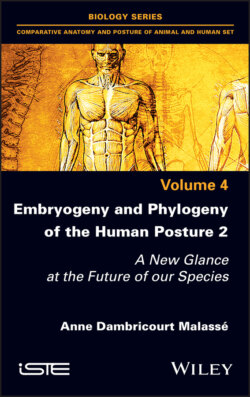Читать книгу Embryogeny and Phylogeny of the Human Posture 2 - Anne Dambricourt Malasse - Страница 11
1.2. Human paleontology, a nascent science
ОглавлениеA new prehistoric Homo sapiens skeleton was exhumed in 1872 on the lands of the Principality of Monaco, in Cavillon, in one of the Grimaldi caves. Everything pointed to a sepulchral context at levels as old as the Cro-Magnon shelter in Les Eyzies-de-Tayac (France), dating back nearly 30,000 years. The stakes were considerable because the remains carried a mantilla composed of more than 200 shells on its head, covered with red ochre and black hematite. The discovery attested to an already highly ritualized and symbolic relationship with death. The mastery of articulated language left little room for doubt. The excavations, however, did not have any means of guaranteeing its date. Prehistory was not yet a scientific discipline.
Armand de Quatrefages studied the Les Eyzies skeletons with his naturalist assistant, the doctor Ernest Hamy (1842–1902). Together they defined the Cro-Magnon race as “the second fossilized human race”, the first being the “Canstadt race” or Neanderthal Man, which was limited to three specimens recognized as: Neanderthal, Gibraltar and La Naulette (see Volume 1). Their study was exocranial, the base of the skull was partially preserved on one of the three adult skulls, but its endocranial surface was not described because of its inaccessibility and there was no question of damaging the unique piece.
New fossils of European Neanderthals enriched the collections in 1886, with three individuals discovered in Belgium in the Spy cave (currently dated at 38,500 years) and especially in Croatia in 1899 in the Krapina cave, with nearly 900 fragmented human remains, nearly 80 individuals dated at 125,000 years old. Traces of anthropophagy would be confirmed.
The great novelty came from Asia with the discovery of fossils of monkeys and great apes, and above all that of a very ancient anthropomorph in Java which generated a great stir among anthropologists. The monkey fossils were collected in the powerful sedimentary deposits of the upper Indus basin called Siwaliks, composed of molasse deposited in the plain by the erosion of the Himalayan range during formation. In the northwestern Indian subcontinent, the deposits were slightly folded and formed the Potwar Plateau. The erosion and scarcity of vegetation gave access to numerous fossiliferous outcrops. Further east, these deposits formed the foothills of the Himalayas, strongly compressed by plate tectonics between India and Asia, sometimes to verticality. The outcrops became long narrow bands covered by tropical forest at low altitude and richer in thorny trees at high altitude. Prospecting conditions were thus limited by vegetation cover and by the small surface area of the fossiliferous layers that inclined rapidly in the depths. The Geological Survey of India (the geological service of the British Empire in India) organized the geological map of the subcontinent. In 1874, Richard Lydekker (1849–1915), a geologist trained at Trinity College, Cambridge (University of Cambridge) was commissioned to map Kashmir, north of the Potwar.
Lyddeker was prospecting the Siwaliks and collecting numerous fossils of vertebrates preserved in the Museum of Calcutta. Among these fossils was a fragment of a monkey’s jawbone collected in 1879. Close to the gibbon, the geologist named it Paleopithecus sivalensis, then in 1886, he described a canine tooth which resembled that of an orangutan. It was the second fossil of a large anthropoid after the mandible of Dryopithecus. Henceforth, the Siwaliks became the cradle of the origin of Man. This perspective was in line with the deductions of Georges Cuvier who thought it was located somewhere in the Himalayan heights, based on paleoclimatic arguments linked to a rise in sea water on a planetary scale. For the high Himalayan peaks, global warming was to result in the melting of the glaciers and the consequent flooding of the plains by the powerful Himalayan rivers.
